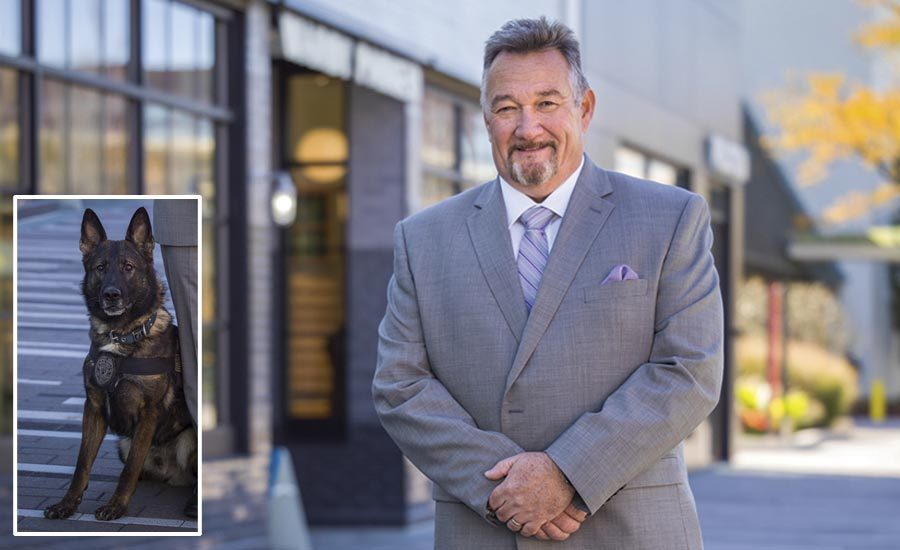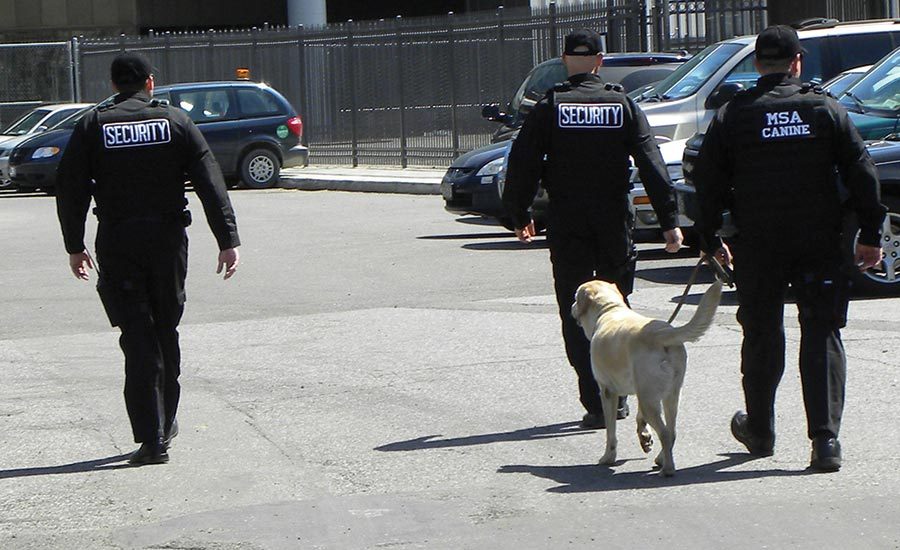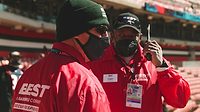Security officer skills and needs are changing due to updated technology and integrated services. End users need a different caliber of security officer who handle more technology- and security management-oriented tasks instead of simply basic patrol, observe and report functions. This provides value to end users’ business units that many don’t consider – but which all appreciate once they come to fruition.
This value-added comes in a number of forms, ranging from canine patrols, to new technology in areas like access management, to the first generation of robot partners – but only if paired with training. For example, Brookfield Properties Retail Group (formerly GGP Inc.), for the past decade has used canine units supplied by what’s now Allied Universal to help search and secure its retail properties and prevent disorderly conduct as well as deter suspicious activity during mall hours. The dogs have proved popular with the public, while also effective in handling the situations we had in mind, says Daniel Ryan, vice president, security.
“The mere presence of a canine gains compliance with disorderly conduct situations – if a fight doesn’t end immediately, a command for the canine to bark ends it very quickly,” he says. Ryan recalls one property at which a canine discovered a group of people lurking in the bushes, dressed in all black. “They refused to come out until the handler threatened to send a dog,” he adds. “They were dressed and equipped to burglarize the mall.”
As security technology develops and matures, security officer skills need to be elevated to match, says Nancy Bentley, senior director, security services and BCP for Northwestern Mutual. “To make sure we can continue operating efficiently and effectively, we really are looking at hiring security officers that have much more of a technically savvy mindset,” she says. “We believe that enhances our customer experience, as well. It just makes for a win-win for everyone.”
MSA Security, which provides explosive detection canines and SmartTech technology for X-ray machines, invests in its people by continuously training them, says Michael O’Neil, chairman. “We stay on top of threats. They’re staying current on trends and methodologies,” he says. “If you go to the lowest common denominator, you’re not going to get the type of people you need to respond. Security professionals are on the front lines. They’re going to be the first ones to engage until the police get there.”
Pairing Training with Technology
New technology or other guarding methodologies must be paired with relevant, adequate training, experts say. Take Northwestern Mutual’s visitor management system. “We can input that information in advance, so when they come into our site, we can automatically understand who they are, who they’re visiting, and get them some credentialing in advance,” Bentley says. “It’s a more efficient, effective and secure process.” Similarly, if the company needs to evacuate a facility, she says, “We can quickly account for people using handheld card readers to able to identify and process them, and know who’s in and out of the building.”
To train officers to understand and use these systems, obtained from AMAG Technology, the company provides a base set of training during the onboarding process and then continues guards’ education as the technology changes or is enhanced, Bentley says. “In terms of day-to-day operations, and understanding what the traffic patterns are, we’re able to leverage that information to make good business decisions about staffing, or how we help people to get around our campus,” she says. “We also use it in terms of emergency response capabilities.”
The set of tools from AMAG enables officers to think beyond guarding and patrolling, to making the customer experience more effective and efficient, Bentley says. “They can think outside the box and provide suggestions on how to enhance the experience, or how the tools might be enhanced to make our operations more efficient. This enables the user to have a better interaction with our security force.”
At Brookfield Properties, the presence of canines and the fully equipped Ford Explorers that come along with such patrols also has helped to deter looting during community-wide crises such as natural disasters like hurricanes Harvey and Florence, Ryan says.
Mall security officers in general have become greater assets to their property owners, he says. “I don’t use the term ‘guard,’ ” Ryan says. “They’re doing incident response, they’re doing surveillance, they’re doing preliminary investigations on incidents and events that occur, in addition to handling response to medical emergencies. There’s already an expectation of a higher caliber of officer and a higher caliber of training in the mall industry in general. Our officers are able to respond to a wide variety of incidents. We need officers who can make quick decisions – and make the right ones.”
Allied Universal (AUS) works in partnership with clients like Brookfield to ensure they’re selecting and hiring the most capable officers, continuously evaluating staffing needs and closely examining pay, benefits and training, says Scott Bickett, vice president – retail for AUS. Ryan adds that security directors are typically former law enforcement or military people. “Our goal is for all of our security officers to be trained and capable,” he says. “There are a lot of amazing stories of what these security officers do that I think are overlooked by the public.”
Companies can invest in high-end technology, but if they have lowest-common-denominator staff, that’s not going to help, O’Neil says. “Personnel costs are heavy in any company, in any industry,” he says. “But I do believe that the more you inform people about the threat, even the people in charge of making money at these companies start to understand that not providing a quality, safe environment for people has a cost, as well.”
Security staff need to be trained in how to respond to threats like active shooters and improvised explosives, O’Neil says. Executives with the proper awareness “are demanding that their security staff is trained in identifying properly what to do,” he says. “What is our active shooter protocol? What are we doing in those first few minutes? What is our response? Not just security staff, but anybody in the building.”
Security staff also need to be compensated well enough to prevent turnover, or “the training session you gave last week, that person moved on,” O’Neil says. “Paying people better gets them to stay in their jobs; then the company can benefit from whatever training you’re giving. If I’m investing in people, I don’t want to lose them. I try to make them comfortable.”
Losing trained talent is like a team losing a key player, he says. “We focus on benefits, and we find the employees love professional development,” he says. “We try to give back to them through training. You don’t have to be the highest paid, but you want to be competitive. Through their benefits, their pay and challenging them professionally, the best thing you can get is a long-term employee who wants to grow in your company.”
Training to Partner with Robots
It’s only just begun, but the next generation of security personnel will need to be trained to work alongside – you might say partner with – robots. Dr. Travis Deyle, CEO and founder of Cobalt Robotics, estimates less than 500 robots have been deployed worldwide for use in physical security. But he foresees three growing uses: outdoor drones in the sky, outdoor robots on the ground for deterrence and indoor robots for real-time response.
“You see that reflected in the product offerings that are starting to be rolled out,” he says. “A large part of what’s needed will be training – going through and becoming familiar with the systems, and then using their tools as force multipliers. There’s a lot of change management. You need to set realistic expectations for what robots can do today, and then iterate and refine over time, using customers who are in the loop to do it.”
Robots essentially allow one trained human to be in many places at once, Deyle says. “As a robot is moving around the space, it’s building up a profile of what’s normal and detecting anomalies,” he says. “They’re good at detecting but not good at triage. You need to train remote robot specialists – guards combined with a security service – to basically jump into the robot’s body, assess what’s going on and then respond. How do you meld the man and the machine? There’s pretty substantial training that has to happen to make them effective.”
But as the technology gets perfected and training advances, people and robots will make strong teams, Deyle believes. “Robots have unique benefits; people have unique benefits,” he says. “People are very flexible in how we think and good at getting rapid context. From a cultural perspective, people are more comfortable engaging with another human being. But robots can operate with unwavering attention. They detect leaks and spills, hear incredibly well and see in the dark. It really comes down to exploiting the capabilities unique to both, and marrying them in a way that’s better than the sum of its parts.”
In the same way that access control and cameras enhance rather than replace humans, robots help fill in gaps. “It’s profound, and enabling,” Deyle says. “The big challenge is on education, clearly identifying use cases. We have to be honest in marketing what robots can do today, what they can’t do today and what they could do tomorrow. Right now, we tend to target times and locations that are relatively low activity, like nights and weekends. In a busy office, we probably wouldn’t have a robot around. It would be better to have a manned guard.”
Stacy Dean Stephens, executive vice president and chief client officer for Knightscope, says his company offers robots on a subscription basis, rather than for sale, which limits the need for certain types of training for guards while giving clients the benefit of their presence and the data they generate. “It allows us to provide the clients with all the software upgrades, firmware upgrades, service, maintenance and everything else that would be a headache for the end user. And it frees them up to reap the benefits of all the data-gathered by Knightscope’s security robots.”
Like humans, robots have five senses – actually sensors – Stephens notes. These are lasers, sonar, GPS, wheel encoders (which track movement and turning) and inertial measurement units (which track tilting and shaking). Combined together, this data forms a very accurate, three-dimensional picture of a robot’s surroundings, which the units use to plot a course through complex environments shared by adults, children, animals, cars and more.
“Robots won’t ever 100-percent replace human guards,” he says. “They will make them more effective, reducing their workload down to what requires human thinking.” They provide 360-degree video, two-way audio, license plate recognition, thermal imaging and signal detection for mobile devices. “All of those sensors are looking for anomalies so [guards] can evaluate the threat level and act upon it.”
Robots also don’t fall prey to certain human weaknesses, Stephens says, which make them pair nicely with humans if used in the right ways. “Like any other industry, we have our challenges; and if we’re sober and honest about it, boredom and monotony are certainly among them,” he says. “Robots handle tedium very well, whereas people do that very, very poorly. You need to look at this type of technology not from the standpoint of, ‘how do I replace Fred,’ or ‘how do I replace a shift,’ but from a holistic standpoint. People are good at interacting, strategy and planning. If you can marry these two together, it’s a recipe for success.”
Guards need to become comfortable with technology and learning new ways of doing things, as well as practical knowledge such as, “What are my procedures going to be if I get a thermal alert off a robot?” Stephens says. “Once you get past that, and recognize that this is another piece of technology providing you information, the training becomes easy and rudimentary. This is what one should expect the robot to do in a given situation. If it’s doing X, Y or Z, that’s normal. If it’s doing A, B or C, that may not be normal.”
Ultimately, robots provide excellent deterrence as a force multiplier, Stephens says. “Anything you can do to swell the appearance of that deterrence, to make it larger than it appears to be, is only going to serve to improve safety,” he says. A robot moving through a space with its lights flashing and sounds whirring makes people sit up and take notice rather than burying themselves in their phones, he adds. “Now the worst enemy of a criminal exists: somebody who is paying attention.”
An organization putting its logo or colors on a robot can be a brand enhancer that not only reduces crime but changes the internal dynamic away from security being a necessary evil to cost savings. Clients of Knightscope have reported drastic declines in crime level, even to 100 percent, while at least one found annualized savings of $250,000, Stephens says. “They have an incredible new dynamic to consider,” he says.
Citizens Bank, a Knightscope customer, had relied heavily on standard tools such as manned guarding and fixed cameras prior to integrating security robots, says Derek Lemire, vice president and senior physical security specialist. “Knightscope is one more tool we use to proactively identify threats,” he says. “Being able to integrate a web-based platform drives our offices to be responsive and forward thinking.”
The training required has been minimal, and the system has been easy to incorporate into the security operations center’s daily tasks, Lemire says. “The platform is easy to use,” he says. “Training literally takes minutes, and operators can confidently use the platform. … Having well-trained personnel and competitively paid officers pay dividends with your colleagues and customers on an everyday basis.”
The deployment of the Knightscope robot has paid dividends as well, Lemire says. “The robot has been a huge hit with our colleagues,” he says. “Thousands of social media posts, news articles and selfies have been taken with the robot. We also had a contest to name the two devices currently in operation.”
Challenges Facing the Industry
While these and many other companies have taken the right steps, too many organizations haven’t yet crossed the bridge toward modern guarding forces, says Tom Conley, president and CEO of The Conley Group. “Organizations, by far, are still not taking their security for real,” he says. “People still want minimum wage level, what I call ‘traditional guards,’ with little pay, training or experience, who do observe and report only. My belief is that those folks bring no value to an organization, and in fact organizations that hire those people are putting them in an unsafe position. They’re putting a uniform on, but they don’t have training or capabilities.”
The problem starts with the fact that government fails to mandate any training for security officers – and yet requires that cosmetologists, for example, receive hundreds of hours, Conley says. That lack of requirements invites the hiring of unqualified but inexpensive guards. “The guard industry needs to transition to the security profession,” he says. “The reason those people are in danger is that anybody who wears the uniform is a potential target for a bad guy. You think about the absurdity – the least paid and least qualified person in the building is the person who has the most responsibility for life safety.”
Organizations need to think of security as a risk mitigation tool – but too many over-accept and under-mitigate risk, Conley says. “Most organizations view security as an add-on, as opposed to part of the core business functions,” he says. “The reason they’re a core part of the organization is because risk management is a core part of the organizations – and security, when it works right, is part of risk management.”
Some executives think they can insure away risk, but insurance only pays for compensatory damages – not punitive damages that can arise from a gross negligence finding, Conley says.
“The organization has this huge liability hanging out,” he says. “That over-acceptance and under-mitigation of risk exposes them to far more of a potential loss than if they just did the correct security program, and got quality people that were well-paid, had benefits, had certifications and professional qualifications. That not only has a high probability of precluding bad things from happening, but if they do happen, the damages are going to be compensatory, not punitive, even if the finding of fact goes against you. When people think they’re saving money by getting cheap security, they’re in fact sitting on a ticking time bomb, both tactically and legally.”
Conley has a few calculations he shares when talking to a chief executive or vice president about their company’s security needs. He will ask what security they currently have, and the answer typically might be, one person at a desk, 24/7. “How do you determine that’s what you need?” he asks. “That’s the way it’s always been,” is a common answer. “Is the person armed? No. What if something bad happens? We call the police,” he recounts. “I’ll ask them, ‘What do you want to happen between the time somebody shows up with a gun and the police arrive on the scene?’”
Conley then points out that if the average police response time his geographic area is 7½ minutes, and an active shooter can fire 15 rounds in 4.5 seconds, “Take 60 x 7½. That’s how many people I can shoot before the first officer gets there. Unless an organization has the proper assets on site before an incident occurs, public safety cannot arrive in time to make a measurable difference in the outcome. They just can’t. It’s not their fault. Investing in a quality security program is an investment, not a cost. … Security decisions cannot be made as if security were a commodity.”
To convince C-suite executives to treat security more seriously, they need to see meaningful metrics, Conley says. “You can’t quantify everything, but you can quantify a lot. We quantify incident reports, police reports, if there’s a loss,” he says. “Every property has its personality. Take a business and move it five blocks, it will have a slightly different risk profile, or personality. That’s why a security management survey is so critical, to determine the risk for that business in that area – and customize a plan based on those risks.”
If a business has ongoing issues with car break-ins, for example, they can start putting measures in place and if they see a 50-percent reduction, that’s positive, Conley says. “That means what we did worked, somewhat. But how do you get it down to single digits? You look at locations and times of day. You look at variables scientifically.”
Companies that continue to use untrained traditional guards “either don’t care, or aren’t willing to listen why it’s important to care,” he says. “They’re not risk-taking; they’re gambling. … If they’re not going to arm their security and do it right, then call them a greeter or an ambassador. They’re not going to be able to take care of themselves or anyone else.”
To truly bring his points home, Conley undertook a calculation with one potential client to figure out what a life was worth to them, based on what they were spending per year on security, what they should be spending to do it right and their number of employees. It came to $145 per person. “That becomes a core question, and the fact that many leaders simply refuse to face the truth is the core problem.”
16th Annual Top Guarding Firms Listing
| Company, Head Office | Offices | Employees Full-time unless otherwise noted | Revenues (USD) unless otherwise noted |
| Allied Universal, Santa Ana, CA | 190 | 140,000 | $5,300,000,000,000 1 |
| Securitas North America, Chicago, IL | 350 | 110,500 | $4,500,000,000 |
| G4S Secure Solutions (USA), Palm Beach Gardens, FL | 127 | 57,000 | $2,400,000,000 |
| US Security Associates, Roswell, GA | 176 | 50,000 | $1,400,000,000 1 |
| National Security Alliance, Dayton, OH | 97 | 14,661 | $405,000,000 2 |
| SOS Security, Parsippany, NJ | 45 | 10,000 | $410,000,000 |
| Walden Security, Chattanooga, TN | 18 | 5,000 | $235,000,000 |
| SecurAmerica, Atlanta, GA | 88 | 10,000 | $300,000,000 |
| Whelan Security, St. Louis, MO | 25 | 6,000 | $212,850,000 |
| First Alarm Security & Patrol, San Jose, CA | 8 | 2,200 | $750,000,000 3 |
| Andy Frain Services, Aurora, IL | 51 | 13,225 | $118,250,000 |
| St. Moritz Security Services, Pittsburgh, PA | 32 | 3,000 | $89,000,000 |
| DSI Security, Dothan, AL | 27 | 4,500 | $65,000,000 |
| Titan Security Group, Chicago, IL | 3 | 1,700 | $66,400,000 |
| Per Mar Security & Research, Davenport, IA | 13 | 2,070 | $57,350,000 6 |
| Sunstates Security, Raleigh, NC | 23 | 2,218 | $675,000,000 4 |
| APG Security, South Amboy, NJ | 24 | 2,200 | $58,925,000 5 |
| Security Solutions of America, Newport, NC | 23 | 1,600 | $48,000,000 |
| Point 2 Point Global Security, Addison, TX | 7 | 2,000 | $59,000,000 |
| Elite Investigations, New York City, NY | 18 | 1,500 | $51,000,000 |
| Monument Security, McClellan, CA | 7 | 900 | $25,000,000 |
| United Security, Red Bank, NJ | 10 | 1,039 | $30,140,000 |
| Security Alliance, Miami, FL | - | 550 | $21,000,000 7 |
Notes. Prepared from responses from CEOs, COOs, or CFOs. Totals are rounded off. 1. Allied Universal announced the acquisition of U.S. Security Associates on July 16, 2018. 2. National Security Alliance (NSA) members, a network of 17 locally owned and operated companies. 3. Purchased by SOS Security on August 8, 2018. 4. Member of NSA.
5. Plus $1.2M in investigative revenues. 6. An NSA member; also $60M revenues in electronics and fire mitigation. 7. Plus $9M in other activities. Special assistance from https://securityproadvisors.com/








